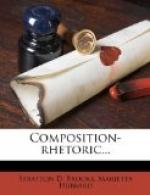A pretty picture the lad made as he lay there dreaming over his earthly possessions—a pretty picture in the shade of the great elm, that sultry morning of August, three quarters of a century ago. The presence of the crutch showed there was something sad about it; and so there was; for if you had glanced at the little bare brown foot, set toes upward on the curbstone, you would have discovered that the fellow to it was missing— cut off about two inches above the ankle. And if this had caused you to throw a look of sympathy at his face, something yet sadder must long have held your attention. Set jauntily on the back of his head was a weather-beaten dark blue cloth cap, the patent leather frontlet of which was gone; and beneath the ragged edge of this there fell down over his forehead and temples and ears a tangled mass of soft yellow hair, slightly curling. His eyes were large and of a blue to match the depths of a calm sky above the treetops: the long lashes which curtained them were brown; his lips were red, his nose delicate and fine, and his cheek tanned to the color of ripe peaches. It was a singularly winning face, intelligent, frank, not describable. On it now rested a smile, half joyous, half sad, as though his mind was full of bright hopes, the realization of which was far away. From the neck fell the wide collar of a white cotton shirt, clean but frayed at the elbows, and open and buttonless down to his bosom. Over this he wore an old-fashioned satin waistcoat of a man, also frayed and buttonless. His dress was completed by a pair of baggy tow breeches, held up by a single tow suspender fastened to big brown horn buttons.
—James Lane Allen: Flute and Violin.
(Copyright, 1892, Harper and Brothers.)
The details are not stated with reference to their natural position in space, but they are given in the probable order of observation. If we were to look upon such a boy, the crutch would attract our attention and would lead us to look at once for the reason why a crutch was needed. The writer skillfully uses the sympathy thus aroused as a means of transition to the face. In the remainder of the description the natural position in space is closely followed.
+Theme LVII.+-Write a description of one of the following:—
1. The bayou. 2. Looking down the mountain. 3. Looking up the mountain. 4. The floorwalker. 5. An old-fashioned rig. 6. A house said to be haunted. 7. The deacon.
(Consider the arrangement of details with reference to their position in space. Consider your paragraphs with reference to coherence and emphasis. Sections 82 and 83.)




